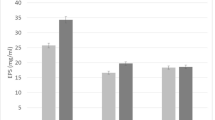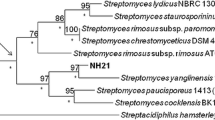Abstract
Silver nanoparticles (SNPs) are extensively used in many industrial and medical applications; however, the impact of their release in the environment is still considered an understudied field. In the present work, SNPs present in aqueous lab waste water (average size of 30 nm) were used to determine their impact on microflora if released in soil rhizosphere and sewage waste water. The results showed that 24 h incubation with different SNP concentrations resulted in a 2.6-fold decrease for soil rhizosphere microflora and 7.45-fold decrease for sewage waste water microflora, both at 24 ppm. Live and heat shock (50 and 70 °C) Aspergillus niger cultures were used to remove SNP waste, the results show 76.6, 81.74 and 90.8 % SNP removal, respectively after 3 h incubation. There was an increase in the log total bacterial count again after SNP removal by A. niger in the following order: live A. niger < 50 °C heat shock A. niger < 70 °C heat shock A. niger. The pH value decreased from 5.8 to 3.8 in the same order suggesting the production of an acid in the culture media. Scanning electron microscopy images showed agglomeration and/or complexation of SNP particles, in a micron size, in between the fungal mycelia, hence settling on and in between the mycelial network. The results suggest that silver was reduced again and agglomerated and/or chelated together in its oxidized form by an acid in A. niger media. More studies are recommended to determine the acid and the heat shock proteins to confirm the exact mode of action.







Similar content being viewed by others
References
Baath E (1989) Effects of heavy metals in soil on microbial processes and populations. Water Air Soil Pollut 47:335–379
Dams RI, Biswas A, Olesiejuk A, Fernandes T, Christofi N (2011) Silver nanotoxicity using a light-emitting biosensor Pseudomonas putida isolated from a wastewater treatment plant. J Hazard Mater 195:68–72
Fabrega J, Luoma SN, Tyler CR, Galloway TS, Lead JR (2011) Silver nanoparticles: behaviour and effects in the aquatic environment. Environ Int 37:517–531
Gomaa O, Selim S, Linz J (2013) Biochemical and biophysical response to calcium chloride stress in Aspergillus niger and its role in malachite green degradation. Cell Biochem Biophys 65:413–423
Gong G, Shao K, Feng W, Lin Z, Liang C, Sun Y (2011) Biotoxicity of nickel oxide nanoparticles and bio-remediation by microalgae Chlorella vulgaris. Chemosphere 83:510–516
Han MJ, Yun H, Lee SY (2008) Microbial small heat shock proteins and their use in biotechnology. Biotechnol Adv 26:591–609
Khan SS, Mukherjee A, Chandrasekaran N (2012) Adsorptive removal of silver nanoparticles (SNPs) from aqueous solution by Aeromonas punctata and its adsorption isotherm and kinetics. Colloids Surf B 92:156–160
Kim YS, Han JA, Cheong TB, Ryu JC, Kim JC (2004) Protective effect of heat shock protein 70 against oxidative stresses in human corneal fibroblasts. J Korean Med Sci 19:591–597
Kim JY, Kim KT, Lee BG, Lim BJ, Kim SD (2013) Developmental toxicity of Japanese medaka embryos by silver nanoparticles and released ions in the presence of humic acid. Ecotoxicol Environ Saf 92:57–63
Larue C, Pinault M, Czarny B, Georgin D, Jaillard D, Bendiab N, Mayne-L’ Hermite M, Taran F, Dive V, Carriere M (2012) Qualitative evaluation of multi-walled carbon nanotube uptake in wheat and rapseed. J Hazard Mater 227–228:155–163
Liu WT (2006) Nanoparticles and their biological and environmental applications. J Biosci Bioeng 102:1–7
Luoma SN, Rainbow PS (2005) Why is metal bioaccumulation so variable? Biodynamics as a unifying concept. Environ Sci Technol 39:1921–1931
Meyer JN, Lord CA, Yang XY, Turner EA, Badireddy AR, Marinakos SM, Chilkoti A, Wiesner MR, Auffan M (2010) Intracellular uptake and associated toxicity of silver nanoparticles in Caenorhabditis elegans. Aquat Toxicol 100:140–150
Mirzajani F, Askari H, Hamzelou S, Farzaneh M, Ghassempour A (2013) Effect of silver nanoparticles on Oryza sativa L. and its rhizosphere bacteria. Ecotoxicol Environ Saf 88:48–54
Nakajima-Kambe T, Edwinoliver NG, Maeda H, Thirunavukarasu K, Gowthaman MK, Masaki K, Mahalingam S, Kamini NR (2012) Purification, cloning and expression of an Aspergillus niger lipase for degradation of poly(lactic acid) and poly (ε-caprolactone). Polym Degrad Stab 97:139–144
Nicholson FA, Smith SR, Alloway BJ, Carlton-Smith C, Chambers BJ (2003) An inventory of heavy metals inputs in agricultural soils in England and Wales. Sci Total Environ 311:205–219
Nowack B, Bucheli TD (2007) Occurrence, behavior and effects of nanoparticles in the environment. Environ Pollut 150:5–22
Papagianni M (2007) Advances in citric acid fermentation by Aspergillus niger: biochemical aspects, membrane transport and modeling. Biotechnol Adv 25:244–263
Radziun E, Wilczyn’ska D, Ksiazek I, Nowak K, Anuszewska EL, Kunicki A, Olszyna A, Zabkowski T (2011) Assessment of the cytotoxicity of aluminium oxide nanoparticles on selected mammalian cells. Toxicol In Vitro 25:1694–1700
Sjöblom A, Meili M, Sundbom M (2000) The influence of humic substances on the speciation and bioavailability of dissolved mercury and methylmercury, measured as uptake by Chaoborus larvae and loss by volatilization. Sci Total Environ 261:115–124
Tamayo D, Munoz JF, Torres I, Almeida AJ, Restrepo A, McEwan JG, Hernandez O (2013) Involvement of the 90 kDa heat shock protein during adaptation of Paracoccidioides brasiliensis to different environmental conditions. Fungal Genet Biol 51:34–41
Velasco-Alvarez N, Gonzalez I, Damian-Matsumura P, Gutierrez-Rojas M (2011) Enhanced hexadecane degradation and low biomass production by Aspergillus niger exposed to an electric current in a model system. Bioresour Technol 102:1509–1515
Xiao B, Yang F, Liu J (2013) Evaluation of electricity production from alkaline pretreated sludge using two-chamber microbial fuel cell. J Hazard Mater 254–255:57–63
Author information
Authors and Affiliations
Corresponding author
Rights and permissions
About this article
Cite this article
Gomaa, O.M. Removal of silver nanoparticles using live and heat shock Aspergillus niger cultures. World J Microbiol Biotechnol 30, 1747–1754 (2014). https://doi.org/10.1007/s11274-014-1597-0
Received:
Accepted:
Published:
Issue Date:
DOI: https://doi.org/10.1007/s11274-014-1597-0




